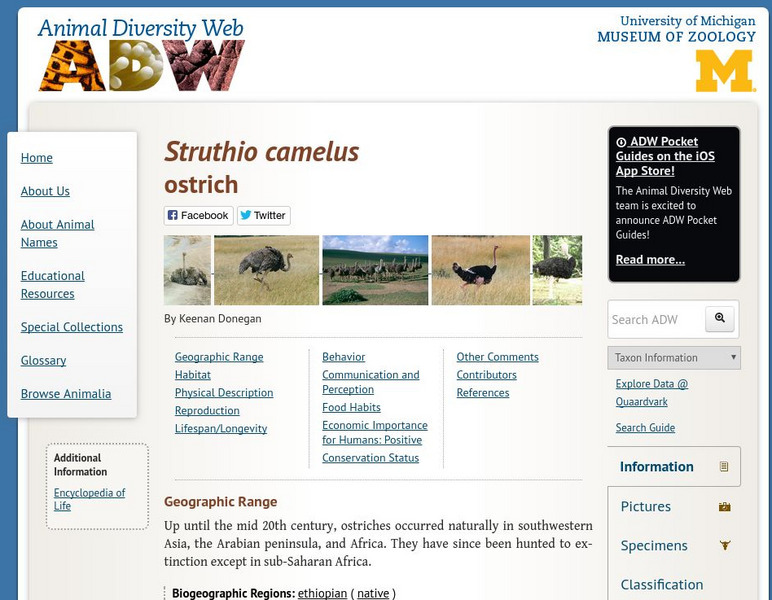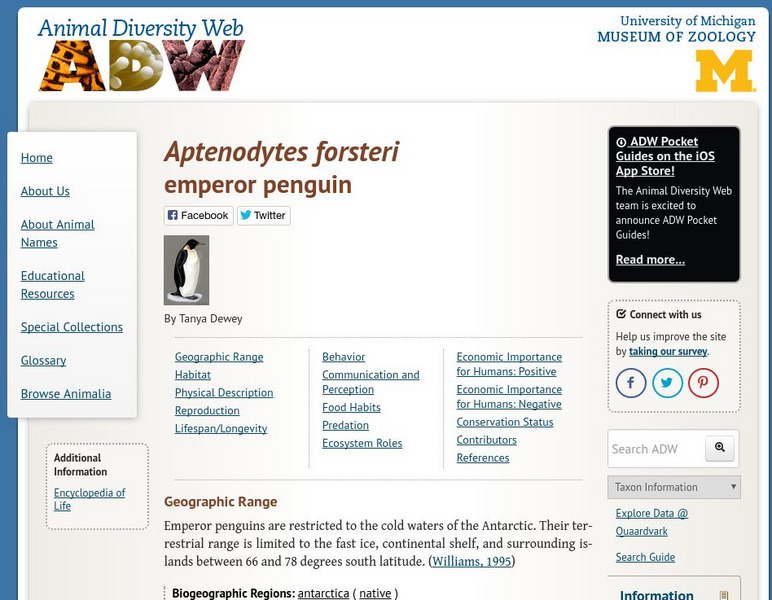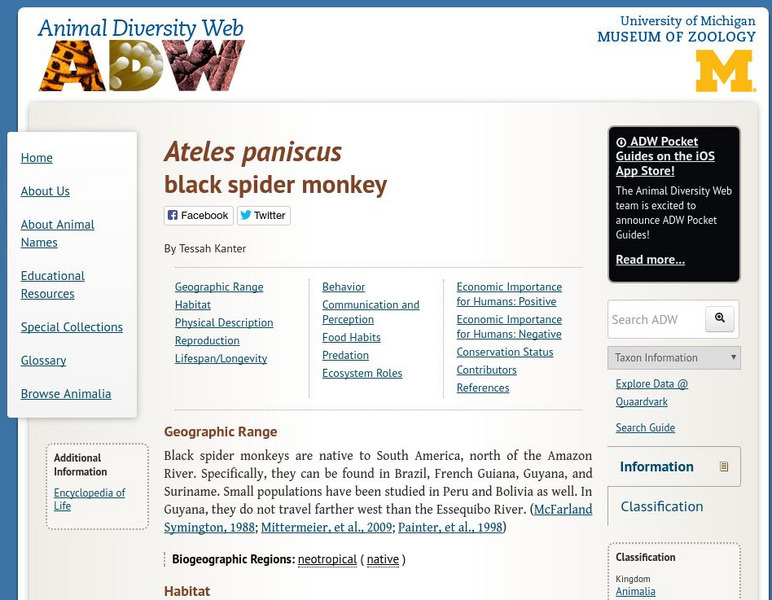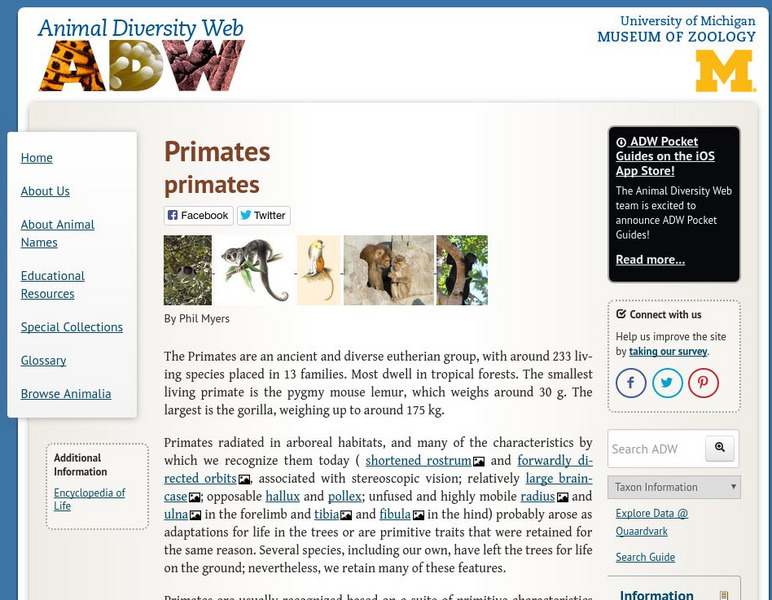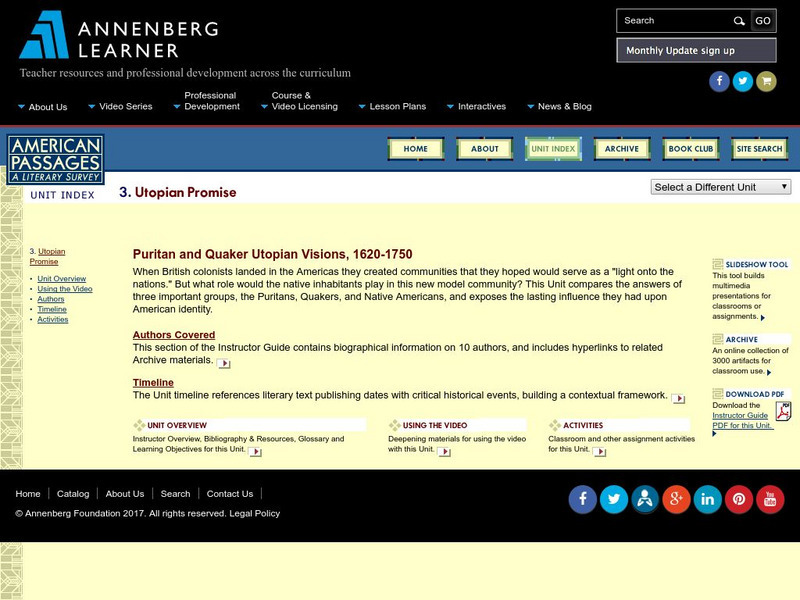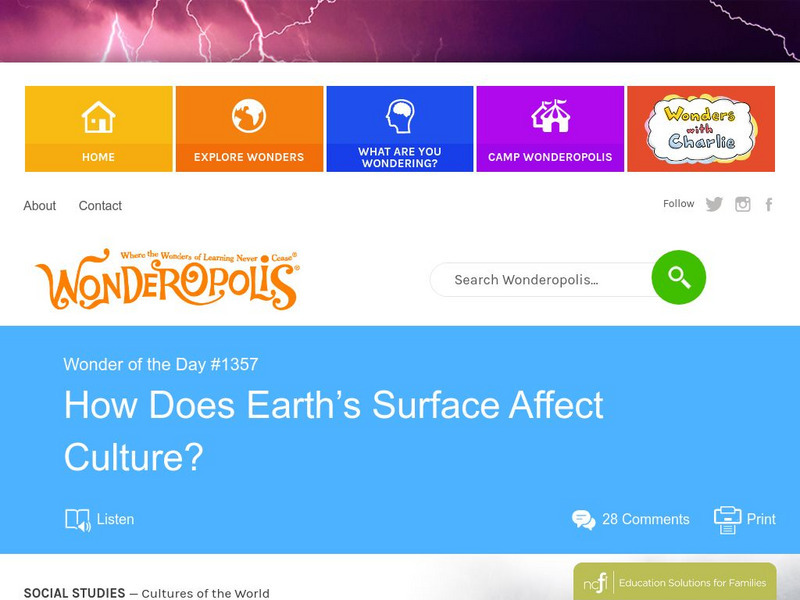Regents of the University of Michigan
Animal Diversity Web: Family Iguanidae (Iguanas)
Resource gives the physical and behavioral characteristics of the iguana, its habitat, food habits, and the ability to live with man.
Regents of the University of Michigan
Animal Diversity Web: Ostrich
Topics delved into in this effective site are geographic range, habitat, physical description reproduction, behavior, diet, economic importance and conservation status.
Regents of the University of Michigan
Animal Diversity Web: Bombyx Mori (Silkworms)
Biological information about the silkworm, Bombyx mori, including habitat, physical description, behavior, food habits, and more.
Regents of the University of Michigan
Animal Diversity Web: Lama Pacos: Alpacas
A detailed description of the Alpaca, including sections on habitat, physical description, reproduction, and communication, among others.
PBS
Nova: The Elegant Universe: Viewpoints on String Theory: Sheldon Glashow
Transcript of an interview with physicist Sheldon Glashow on his attitude toward string theory and its impact on the study of particle physics and cosmology.
American Association of Physics Teachers
Com Padre Digital Library: Open Source Physics: Relative Motion on Elevator Model
What would happen if you played with a yo-yo in a moving elevator? This simulated exercise lets users observe what happens from two perspectives, one being the person playing with the toy and the other being on the outside of a glass...
PBS
Pbs Learning Media: Bird Beak Gallery
This collection of images of ten different birds illustrates the diversity of bird beaks.
Regents of the University of Michigan
Animal Diversity Web: Rockhopper Penguin
This site provides a detailed overview of the Rockhopper Penguin. Content includes a focus on this bird's geographic range, physical characteristics, natural history, and economic importance for humans.
Regents of the University of Michigan
Animal Diversity Web: Tarsius Pumilus
Read about the natural history and physical characteristics of tarsius pumilus, one of four species of tarsiers living in the rain forest. Provided by Animal Diversity Web.
Regents of the University of Michigan
Animal Diversity Web: Emperor Penguin
This site provides a detailed overview of the Emperor Penguin. Content includes a focus on this bird's physical characteristics, geographic range, natural history, economic importance for humans, and more.
Regents of the University of Michigan
Animal Diversity Web: Honey Badger
Overview of the honey badger, with information about physical characteristics, geographic range, reproduction, behavior, and habitat.
Regents of the University of Michigan
Animal Diversity Web: African Buffalo
General reference material on the African, or Cape, buffalo, with information about physical characteristics, geographic range, classification, reproduction, behavior, and habitat.
Regents of the University of Michigan
Animal Diversity Web: Black Spider Monkey
Factual information is provided on the following topics: geographic range, habitat, physical description, reproduction, behavior, diet, economic importance, and conservation status.
CK-12 Foundation
Ck 12: Physical Science: Democritus' Idea of the Atom
[Free Registration/Login may be required to access all resource tools.] Introduction of the idea of the atom and the diversity of matter.
Regents of the University of Michigan
Animal Diversity Web: Order Primates
Part of a larger site on the animal kingdom, this page provides a detailed overview of primates. Click on the various links throughout the page for more descriptions and explanatory pictures.
Annenberg Foundation
Annenberg Learner: American Passages: Puritan and Quaker Utopian Promise
This unit explores the documented perceptions of Native Americans, religious faiths, physical challenges of new lands and how the combination of immigrants and Native Americans shaped the New World. Click on "Activities" for related...
Canadian Wildlife Federation
Hinterland Who's Who: Bats
Get the facts about bats. Canada is home to nineteen different species of bats. Besides finding detailed physical descriptions of several of these, you'll also learn about some of their unique facts and characteristics. Also included in...
Other
Introduction to the Biosphere: Characteristics of the Earth's Terrestrial Biomes
From Chapter 9 of a textbook on physical geography that covers the biosphere. Important vocabulary is highlighted and linked to a glossary. It explains the characteristics of a biome, and describes the features of the eight different...
University of Virginia
Uva Physics: Using Vectors to Describe Motion
Background information on vectors and their use in describing motion in two dimensions. A comparison of Aristotle's and Galileo's perspectives on force and motion is given.
Utah Education Network
Uen: We Are All Different in Many Ways!
This lesson celebrates students's unique physical and personality traits. After reading and discussing the children's book The Crayon Box That Talked by Shane Derolf and Michael Letzig, students will share create their own artwork that...
Other
Wonderopolis: How Does the Earth's Surface Affect Culture?
Cultural geography is the study of cultural components and how they relate to the geography of the places where people live and travel. This article explains how geography influences culture. Included are activities, and a quiz at the...
National Geographic
National Geographic: To Build an Island
"This lesson gives students a basic overview of the geography of islands. They learn where islands are located throughout the world and will study two very different island groups (the Philippines and the British Isles) to illustrate the...
Other
San Francisco Zoo: Barn Owl
Detailed information and fascinating facts about the barn owl include diet, habitat, physical features, behavior, and conservation status.
Utah Education Network
Uen: Habitat Alterations of a Riparia
This field trip is designed to physically immerse students in the concept of habitat alteration focusing on biotic and abiotic habitat alterations.

